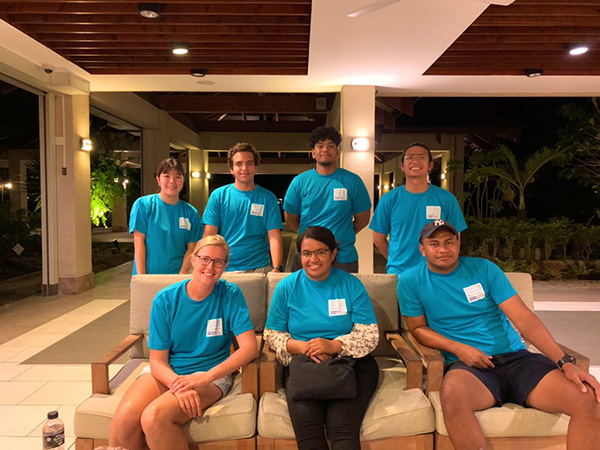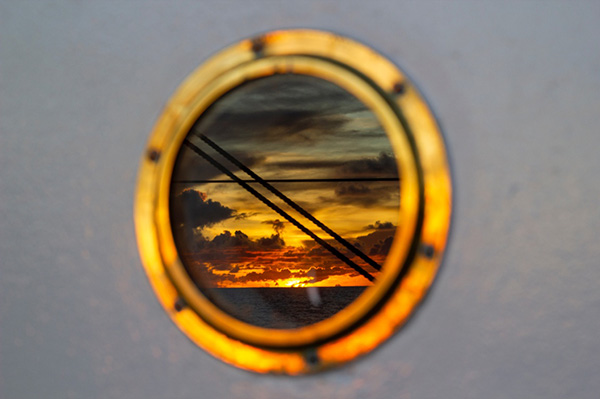Ocean Newsletter
No.540 February 5, 2023
-
Research on Linking Infrasound Monitoring with Tsunami Preparedness
YAMAMOTO Masa-yuki (Professor, School of Systems Engineering, Kochi University of Technology / Head, Infrasound Research Laboratory, Kochi University of Technology)
Earth’s natural phenomena, such as earthquakes and volcanic eruptions, generate infrasound (low-frequency sound) which cannot be detected by human ears. Since 2016, Kochi University of Technology has installed infrasound sensors – which they developed - at 31 locations between Hokkaido and Miyazaki Prefecture to monitor air vibrations. In January 2022, there was a massive eruption on a volcanic island in Tonga. Sea level fluctuations resulting from huge atmospheric pressure fluctuations were transmitted to the sensors at nearly the speed of sound, clearly showing that infrasound observation is effective for tsunami preparedness.
-
The “SDGs Native” Generation and Plastic Pollution
ASARI Misuzu (Associate Professor, Graduate School of Global Environment Studies, Kyoto University)
Today’s elementary, junior high, and high school students have been learning about social issues from a young age; one could say they are the “SDGs Native” generation. With a high level of knowledge and understanding regarding sustainability and SDGs, there have been impressive examples of their efforts and accomplishments related to measures against marine plastic pollution. On the other hand, it has been pointed out that there is a segment of the population that is indifferent. We think that it is important to hold various activities to encourage them to get personally invested.
-
Super Typhoons, Science, and Sailing Onboard Statsraad Lehmkuhl
Lucy DICKIE (Formerly Communication and Public Relations Division, OIST; Okinawa Institute of Science and Technology Graduate School)
Along with others from around the world, I recently had the opportunity to participate in the One Ocean Expedition voyage of the Norwegian tall ship, the Statsraad Lehmkuhl, as part of the UN Decade of Ocean Science initiative. The voyage allowed me to experience the importance of cooperation among the crew members, as well as to learn how the depth and vastness of ocean problems make them global in scale, requiring international cooperation for their solution.
Super Typhoons, Science, and Sailing Onboard Statsraad Lehmkuhl
[KEYWORDS] UN Decade of Ocean Science / nurturing the next generation / international cooperationLucy DICKIE
Formerly Communication and Public Relations Division, OIST; Okinawa Institute of Science and Technology Graduate School
Along with others from around the world, I recently had the opportunity to participate in the One Ocean Expedition voyage of the Norwegian tall ship, the Statsraad Lehmkuhl, as part of the UN Decade of Ocean Science initiative. The voyage allowed me to experience the importance of cooperation among the crew members, as well as to learn how the depth and vastness of ocean problems make them global in scale, requiring international cooperation for their solution.
One Ocean Expedition
If you want to discover how well people can work together when something needs to be done, you could try sticking them on a boat for two weeks, without access to the outside world, and see what happens. It’s a social experiment of sorts and one that took place in the Pacific Ocean between Palau and Yokohama earlier this year.
The boat was the Statsraad Lehmkuhl, a 100-year-old Norwegian tall ship that was 12-months into a 20-month circumnavigation of the globe. The ship left from Bergen, Norway in August 2021 and will return to Bergen in April 2023. This expedition is called the One Ocean Expedition, with the aim of showcasing that, although we come from many different places, we are all connected by the ocean and the challenges that it faces. The One Ocean Expedition is a recognized part of the UN Decade of Ocean Science for Sustainable Development and has partnered with institutes and universities from all over the world—carrying scientists and passionate marine conservationists across oceans using the power of the wind.
One of these institutes is the Ocean Policy Research Institute (OPRI), which is part of the Sasakawa Peace Foundation in Japan. OPRI sponsored six young adults (aged 18-30) to take part in the leg of the journey from Palau to Yokohama, in recognition of the importance of nurturing the next generation of ocean leaders.
I work in science communication with a strong interest in focusing on environmental management. The expedition seemed like a great mix of adventure, research, and meeting like-minded individuals from around the world, all while learning to sail an incredibly cool ship. Plus it meant I got to visit Palau, which is known as a leader in marine conservation. I knew as soon as I saw the post that I would apply.
I was thrilled to be selected alongside Adi Prabowo from Indonesia, Meangeldil Ayla Azuma Malsol and Dean Jr. Rudimch from Palau, Gabriel Mara from Fiji, and Manuel Neves from Portugal. We were also joined by Nana Hashimoto from Japan who works for OPRI.
 Back row, from left: Nana Hashimoto, Manuel Neves, Dean Jr. Rudimch, and Adi Prabowo. Front row, from left: Lucy Dickie (me), Meangeldil Ayla Azuma Malsol, and Gabriel Mara. This photo was taken in Palau on August 26th, the day before we boarded the ship.
Back row, from left: Nana Hashimoto, Manuel Neves, Dean Jr. Rudimch, and Adi Prabowo. Front row, from left: Lucy Dickie (me), Meangeldil Ayla Azuma Malsol, and Gabriel Mara. This photo was taken in Palau on August 26th, the day before we boarded the ship.
Collaboration across countries is key
The first few days of the expedition were so calm that it hardly felt like we were on a boat. As evening approached, we were treated to incredible sunsets with rays of orange and pink. At night the ship was blanketed by clear skies and the milky way.
 Porthole reflections on Statsraad Lehmkuhl.
Porthole reflections on Statsraad Lehmkuhl.
We helped to sail alongside a permanent crew of 25, and many other individuals, mainly from Norway. As part of the blue watch, I was in the team that worked 8am-noon and 8pm-midnight. We manned the lookout and buoy posts, learned how to steer the ship, and kept an eye out for fire. And, depending on the conditions, we hoisted sails, furled sails, and climbed the rigging. We were taught the names of different types of ropes and how to tie different knots. And we developed an impressive and painful number of blisters on our hands.
But in our free time, and in the absence of Wi-Fi, we learned each other’s stories and different perspectives on marine conservation. The diversity present on the ship, shown through the countries we’re from, our first languages, and our different educational backgrounds, enriched the voyage. It's certainly a unique experience to sit at a table and hear discussions in Palauan through one ear and Norwegian through the other.
Ayla later summed this up perfectly by saying, “I’ve just met people from Fiji, Indonesia, New Zealand, Norway especially, and they’re all very passionate about marine conservation, even though they come from different backgrounds. I’ve learned so much from them, especially just being encouraged by what they have done.”
There were also scientists onboard—marine scientists from the Japan Agency for Marine-Earth Science and Technology (JAMSTEC) who launched three Argo floats, and student researchers from Norway who collected data on microplastics and oceanography. This aligned with the goal of the whole expedition, which was to create attention and share knowledge about the crucial role of the ocean for a sustainable development in a global perspective.
Chasing a super typhoon
As we headed north, the calm conditions started to change. Typhoon Hinnamnor, the first super typhoon of 2022, was developing near southern Japan. The estimated wind speed would eventually reach 140 knots. The captain saw this typhoon as an opportunity to hoist the sails and get the ship moving as fast as possible. As we entered the typhoon bands, and as the swell picked up, several trainees (including myself) got seasick, and the ship became increasingly difficult and exhausting to walk around on.
One night, the blue watch was woken up at 5am to assist another watch with turning the boat. The winds had simply gotten too strong and we needed to sail back to calmer waters. We emerged on deck to the first light of the day and found the ship rocking from side to side, and the other watch, half drenched by ocean spray, heaving at ropes, the watch leaders yelling above the wind.
As Gabriel said a few days later, “to keep this ship moving through the rough seas, one person or one team alone couldn’t do it. It’s the same thing for the environment, one country, one person, one movement, one organization, is not enough. We need to work together. I guess this expedition has really shown me that international cooperation and cooperation at every level is essential. And I can see that it is working well on this ship.”
Turning the world upside down
This perspective was only highlighted throughout the rest of the voyage. Later, in a seminar series put together by Adi, Gabriel, and Norwegian voyage trainee Henny Lie-Skarpholt, the different issues facing fishery resources in their countries were discussed. In this series, they pointed out the benefit of the upside-down map. A traditional map highlights northern hemisphere countries and doesn’t do the importance of the ocean justice. But flip the map over and the importance of the ocean, which covers a full 71% of the planet’s surface, becomes much more obvious. A shift in perspective and sharing of knowledge is called for to transform the world.
The issues caused from climate change, ocean plastics, and unsustainable fishing are present the world over. As all on board cooperated in the tasks necessary to keep the ship moving through the ocean, only through international collaboration in which all countries participate can we hope to solve these global issues.
I hope to continue to work in science communication and also move more into environmental social science research to help with marine conservation, especially in the Asia-Pacific region.
